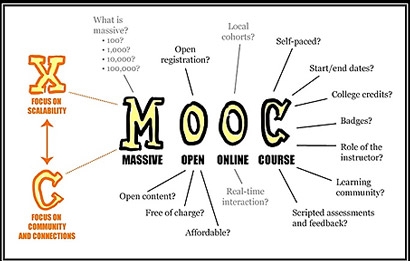The first set of large-scale experiments with massively online open courses (MOOCs) is being evaluated by the academic community. These experiments have ranged from a plethora of single offerings at individual institutions to several well-publicized consortia, such as those founded by MIT and Harvard (edX), Stanford (Coursera), and the European Union (OpenupEd). Udacity is another popular third-party platform with an international reach, to nearly 200 countries. This mode of free, or nearly free coursework has also been promoted by a number of civic-minded philanthropists such as Michael Saylor, Laurene Powell Jobs, and Bill and Melinda Gates.

At first consideration it seems like a wonderful opportunity to be able to take MIT’s first-year electrical engineering course or a Stanford course on political science at your leisure at no cost, except for the internet connection and receiving screen.
I had the pleasure of attending a strategy and management forum on the future of engineering education, sponsored by ASME and the NSF. The second plenary session was devoted entirely to the topic of MOOCs, and the speakers shared some findings from an evaluation of the first wave of MOOC experiments, and the potential impact on higher education. Among the data considered was the number of MOOC enrollments compared to the number of completed courses. Registrants for well-known MOOC programs, such as those offered by MIT and Stanford, for example, sometimes exceeded 150,000 per course, whereas the number of students who completed the course requirements was typically less than 5%. On one hand, the low percentage of completion could indicate that success is questionable. However, in terms of reaching individuals, nearly 5% means nearly 7500—via a typical face-to-face course, this could take decades.
Also interesting are the demographics of the course registrants. For a course in “innovation and entrepreneurship” recently organized and hosted by the Penn State School of Engineering, 80% of the students already had college degrees, more than 70% were international, and—of particular value to the underrepresented engineering profession—more than 60% of the registrants were female.
As an experiment in bringing world class higher education content to anyone in the developed world with interest, these ventures appear successful and should be applauded. Important questions remain pertaining to how this enterprise will mesh with traditional teaching methods on the hosting campus and who will pay for course development and execution, given that most of the registrants are off campus and not paying for services.
This question about the appropriate business model parallels the discourse concerning open access to scholarly publications. There are clear and admirable benefits of distributing the world’s knowledge either in courses or in scholarly publications in an open format and available to anyone in the world with a connection to the Internet, but somebody needs to pay to produce and to host this high-value content online.
From the MOOC experiments, we see emerging local benefits for the MOOC producers that may justify the host institution footing the bill for course production. Recent experiments with so-called “flipped classrooms” are showing the benefits of teachers spending more time with one-on-one exercises or lab projects and leaving the traditional lectures to self-paced online instruction. In such arrangements, the course material prepared for MOOCs becomes an integral or at least an important supplement to the host institution’s course material worthy of local investment. In this hybrid format, the on-campus student gets the combined benefit of the professor’s (or teaching team’s) extensive effort put into developing a high-quality online product with production qualities suitable for a mass audience, in addition to the benefit of personalized face-to-face time with the professor.
The online student does not get this key benefit of the on-campus experience. Creative additions that facilitate learning online with discussion groups and various social media don’t yet substitute in my book. I still treasure the days I spent in the classrooms, labs, hallways, and professor offices during my student days at MIT (some 40 years later). Perhaps when there are full holographic remote interactions, I will change my mind.
My alma mater was experimenting in online education well before the word MOOC became fashionable in the higher education market. MIT faculty started putting their courses online in 2002; materials from undergraduate and graduate courses alike were made available to the public for free or partly free. By October 2012, almost 2200 of the courses in the hefty MIT course catalog were online.
At the APS April meeting, there was a full session dedicated to impacts and experiences with MOOCs in physics. Some institutions leverage their MOOC offerings to augment their regular face-to-face introductory college courses. Speakers examimed the MOOC user demographics, as well as the differences/similarities in the "take aways" between the students who learn via MOOC and those who learn in a traditional classroom.
The proliferation of MOOCs brings up the question of certification. If a bright and adventurous student in a land far, far away takes and “passes” all of the freely available courses for a particular MIT major, could that student be awarded an MIT degree without stepping on campus and without paying tuition (just over $43k for the 2013–14 school year)? For now, the answer is no. But many MOOCs do offer certificates of completion.
Yet because MOOCs are still relatively new, questions about certification/accreditation and other concerns continue to be weighed and evaluated. These digital offerings present both threats and opportunities to institutionalized education; they are also changing the way we receive education and interact with our “classmates” and instructors. I believe that this movement will drive progress and leave some tradition in its wake.
